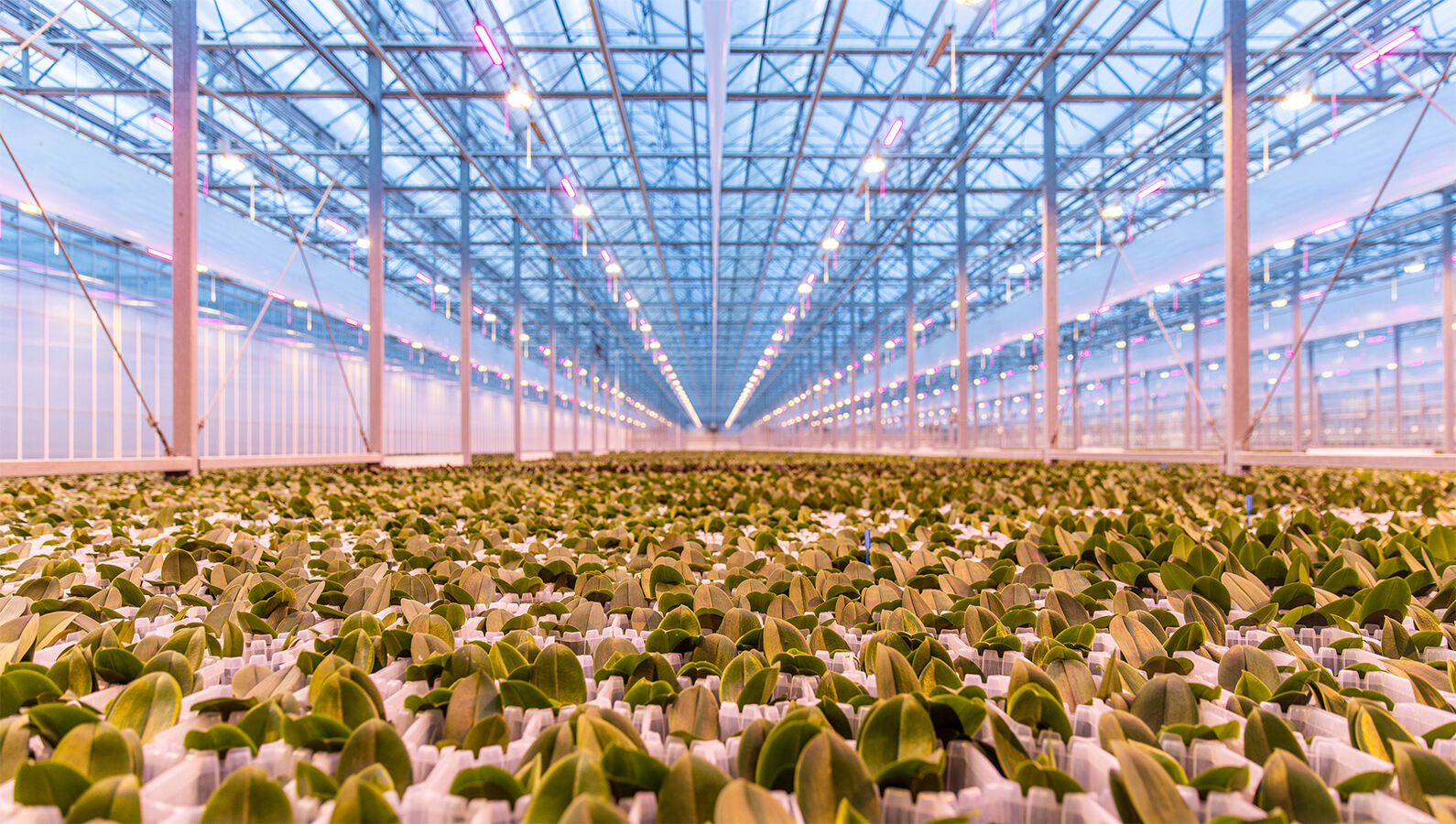Superior Light Transmission and Uniform Diffusion in Glass Greenhouses
Why Glass Maximizes PAR Light for Optimal Plant Growth
Glass greenhouses let through around 90 to 95 percent of the light that plants actually need for growing, which is way better than what we get from polycarbonate materials (about 70 to 88%) or regular plastic films (roughly 75 to 85%). This means plants inside these glass structures get all those important light wavelengths they really need for photosynthesis work properly, particularly the blue light around 450 nanometers and red light at about 660 nanometers where chlorophyll works best. Researchers looking at crops back in 2023 noticed something interesting too. Lettuce plants grown in glass houses reached maturity about 12% quicker compared to those in plastic greenhouses simply because there was so much more usable light available for them to grow on.
Case Study: Higher Tomato Yields in Glass vs. Polycarbonate Units
Tomato farmers in the Netherlands have seen their harvests jump by around 18% when growing under glass greenhouses instead of those made with polycarbonate panels. Glass structures keep about 92% of sunlight coming through throughout the whole year, whereas most polycarbonate materials start losing effectiveness pretty quickly, dropping down to only 79% transmission after just 18 months exposed to UV rays. That difference in available light translates into roughly 3.2 extra kilograms per square meter of tomatoes each season. For commercial growers aiming at producing well over 60 kg per square meter yearly, this kind of boost makes a real difference in profitability and efficiency across their operations.
Innovation: Anti-Reflective Coatings and Improved Light Distribution
The latest generation of glass greenhouses comes equipped with special anti-reflective coatings that cut down on surface reflections quite dramatically—from around 8% down to just 1.2%. This means there's roughly 7% more usable light getting through the glass than before. Pair these coatings with prismatic glass designs that spread light across a much wider angle—up to 120 degrees—and suddenly those annoying shadow patterns we used to see in older greenhouse models disappear completely. Some recent testing at agricultural research centers has actually demonstrated pretty impressive results too. Basil plants grown under these new systems showed a 19% increase in their leaf area index during those tough winter months when natural light levels drop off so much.
Strategy: Designing Crop Layouts to Leverage Consistent Light Spread
To get the most even light spread through glass structures, farmers should line up their crops running east to west so they all get similar sunlight throughout the day. Adjusting plant heights with movable systems keeps them around 30 to 50 centimeters beneath the glass roof where light penetration is best. Growing tomatoes and peppers alongside basil or thyme works well since these combinations take advantage of different light levels naturally. A recent test at the University of Nebraska showed that this kind of vertical layering boosted farm productivity by nearly half compared to traditional setups, making it an attractive option for greenhouse operators looking to maximize space without compromising yield.
Thermal Performance and Temperature Regulation with Glass Panels
Glass greenhouses offer superior thermal management through material properties and adaptable design, making them ideal for precision climate control in diverse environments.
The Role of Thermal Mass in Stabilizing Greenhouse Temperatures
Glass has high thermal mass, absorbing solar energy during the day and releasing it slowly at night. This natural heat retention reduces temperature fluctuations by up to 15% compared to plastic alternatives, protecting cold-sensitive crops like tomatoes and orchids from nighttime chilling.
Single vs. Double Pane Glass: Insulation Efficiency and Energy Savings
Insulated Glass Units (IGUs) significantly improve energy performance:
| Configuration | U-Value (W/m²K) | Heating Cost Reduction |
|---|---|---|
| Single Pane | 5.7 | Baseline |
| Double Pane/IGUs* | 2.8 | 40% |
*Insulated Glass Units (IGUs) with argon gas fill minimize heat loss, especially crucial during winter months.
Case Study: Energy Use in Cold Climates Using Insulated Glass Units (IGUs)
A 2023 analysis of Nordic commercial growers showed IGUs reduced heating costs by 35% compared to single-pane systems. With higher yields and lower fuel use, the 10-year return on investment exceeded 200%.
Strategy: Managing Ventilation and Heat Retention for Climate Control
Optimize thermal performance with automated roof vents for rapid cooling, thermal screens to retain warmth on sub-zero nights, and strategic placement of IGUs on north-facing walls to reduce heat loss. These methods extend growing seasons in temperate zones and cut annual energy consumption by up to 22%.
Durability, Longevity, and Structural Considerations of Glass Greenhouses
Glass vs. Plastic: Lifespan and Resistance to Degradation
High-quality glass greenhouses last 30+ years, far exceeding polycarbonate's 10–15-year lifespan. Unlike plastic, glass resists UV degradation, maintaining clarity and structural integrity over decades. A 2023 Sustainable Agriculture Review found glass retained 92% light transmission after 20 years, versus 67% for polycarbonate.
| Factor | Glass | Polycarbonate |
|---|---|---|
| Lifespan | 30+ years | 10–15 years |
| UV Resistance | Non-degrading | Yellowing over time |
| Impact Resistance | Low | High |
| Annual Maintenance | 2–3 cleaning cycles | 5+ repairs |
Annealed vs. Tempered Glass: Strength and Safety Trade-offs
Tempered glass is heat-treated to achieve four times the strength of annealed glass, reducing breakage risk by 80% (Glass Safety Council 2023). Though 30% more expensive, it shatters into safe, blunt granules—making it ideal for hail-prone areas. Annealed glass suits budget builds but benefits from protective film to enhance safety.
Overcoming Fragility: Reinforced Framing and Impact Resistance
Advances in engineering have addressed glass brittleness through aluminum alloy frames with thermal breaks, laminated interlayers that hold cracked panels together, and arched, snow load-rated designs (≥30 lbs/sq ft). A 2022 Colorado trial found these upgrades reduced storm-related damage claims by 62% compared to standard installations.
Cost Analysis and Maintenance Requirements of Glass Greenhouse Systems
High Upfront Costs vs. Long-Term Value of Glass Construction
Glass greenhouses cost about 2 to 3 times more upfront compared to polycarbonate options because they need special frames and professional setup. But this extra expense pays off in the long run since glass structures can last well over 30 years. According to research published in 2023 on greenhouse materials, glass maintains around 95 percent of its original strength even after twenty years of use. Plastic alternatives start showing signs of wear much sooner though. Most polycarbonate panels begin to turn yellow and lose their clarity within just eight years of installation, which affects how much sunlight gets through to plants inside.
Lifecycle Cost Comparison: Glass vs. Polycarbonate Over 10 Years
| Cost Factor | Glass Greenhouse | Polycarbonate Greenhouse |
|---|---|---|
| Material + Labor | $42,000 | $18,500 |
| Energy Expenditure | $12,300 | $9,200 |
| Panel Replacements | $1,200 | $14,500 |
| 10-Year Total | $55,500 | $42,200 |
Despite higher upfront and energy costs, glass becomes more economical after year 14 due to minimal replacement needs, unlike polycarbonate, which typically requires full panel replacement every 5–7 years in high-sunlight regions.
Strategy: Preventive Maintenance to Reduce Repair and Replacement Costs
Proactive care prevents 82% of common failures. Key practices include weekly sealant inspections, monthly frame alignment checks, gutter debris removal, annual application of silicone-based glazing compounds, and using pH-neutral cleaners to prevent etching. According to 2024 horticultural facility reports, this routine reduces annual maintenance expenses by $580 compared to reactive repair models.
Ideal Climate and Design Applications for Glass Greenhouse Structures
Performance in Sunny and Arid Regions: Managing Solar Gain and UV Exposure
Glass greenhouses work really well in places where there's lots of sun because they block those damaging UV rays but still let through around 88 to 92 percent of visible light. That's actually better than what we get with polycarbonate materials which only transmit about 80 to 85 percent. For plants that need plenty of PAR levels, think tomatoes and peppers, this makes a big difference. When it comes to hot dry areas like parts of the Middle East or the Southwestern United States, things inside these structures can get quite warm sometimes reaching over 95 degrees Fahrenheit if nothing is done about it. The good news though is that today's technology offers some great fixes. There are special coatings applied to glass that absorb UV light and cut down on heat buildup by roughly 15 to 20 percent all while keeping the light quality intact according to recent findings published in the Horticulture Lighting Report for 2023.
Trend: Integrating Shade Curtains and Passive Cooling Systems
Retractable shade curtains paired with evaporative cooling pads are now standard in hot-climate glasshouses. A 2022 case study showed that combining 40% shade cloth with horizontal airflow fans cut cooling costs by 32% on Arizona melon farms. For passive efficiency, ridge-and-furrow roof designs enhance natural ventilation, reducing dependence on mechanical HVAC systems.
Aesthetic and Functional Advantages in Botanical Gardens and Urban Farms
Glass's clarity and even light diffusion make it ideal for public spaces like botanical gardens, where visual appeal enhances visitor experience. In urban vertical farms, glass panels used alongside LED grow lights deliver 20% higher basil yields than polycarbonate setups, thanks to superior light uniformity.
Strategy: Customizing Glass Greenhouse Design for Local Microclimates
Adapt glass greenhouse designs to regional conditions:
- Desert zones: Use low-emissivity glass with exterior whitewash coatings to reflect excess heat
- Tropical regions: Implement open-roof systems with integrated rainwater drainage
- Temperate areas: Install double-pane IGUs for improved winter insulation
Research indicates customized designs improve energy efficiency by up to 40% over generic models (Greenhouse Engineering Review 2024).
Frequently Asked Questions
What is PAR light and why is it important for plants?
PAR stands for Photosynthetically Active Radiation, the spectrum of light that plants utilize for photosynthesis. Glass greenhouses transmit 90-95% of this light, optimizing plant growth.
How do glass greenhouses compare to polycarbonate ones?
Glass greenhouses offer superior light transmission, thermal performance, and longevity compared to polycarbonate options. They are more expensive initially but prove economical in the long run due to their durability.
What are the benefits of anti-reflective coatings on glass greenhouses?
Anti-reflective coatings reduce surface reflections and increase usable light penetration, improving plant growth by distributing light more evenly within the greenhouse.
How does the thermal performance of glass greenhouses benefit crops?
Glass greenhouses have high thermal mass, stabilizing temperature fluctuations and protecting cold-sensitive crops. Double-pane IGUs also enhance insulation, reducing heating costs significantly.
What maintenance is required for glass greenhouses?
Preventive maintenance includes regular inspections, cleaning, and the use of protective sealants to ensure the longevity and efficiency of the glass structures.
Table of Contents
- Superior Light Transmission and Uniform Diffusion in Glass Greenhouses
- Thermal Performance and Temperature Regulation with Glass Panels
- Durability, Longevity, and Structural Considerations of Glass Greenhouses
- Cost Analysis and Maintenance Requirements of Glass Greenhouse Systems
- Ideal Climate and Design Applications for Glass Greenhouse Structures
- Performance in Sunny and Arid Regions: Managing Solar Gain and UV Exposure
- Trend: Integrating Shade Curtains and Passive Cooling Systems
- Aesthetic and Functional Advantages in Botanical Gardens and Urban Farms
- Strategy: Customizing Glass Greenhouse Design for Local Microclimates
-
Frequently Asked Questions
- What is PAR light and why is it important for plants?
- How do glass greenhouses compare to polycarbonate ones?
- What are the benefits of anti-reflective coatings on glass greenhouses?
- How does the thermal performance of glass greenhouses benefit crops?
- What maintenance is required for glass greenhouses?


